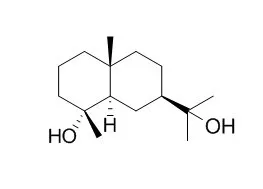| In vitro: |
| Chem Biodivers. 2012 Aug;9(8):1500-7. | | Melanogenesis inhibitory activity of sesquiterpenes from Canarium ovatum resin in mouse B16 melanoma cells.Melanogenesis inhibitory activity of sesquiterpenes from Canarium ovatum resin in mouse B16 melanoma cells.[Pubmed: 22899610] |
METHODS AND RESULTS:
Cryptomeridiol (1), 4-epiCryptomeridiol (2), and cadin-1(14)-ene-7α,11-diol (4), exhibited inhibitory effects with 27.4-34.1 and 39.0-56.9% reduction of melanin content at 50 and 100 μM, respectively, with no or very low toxicity to the cells (80.9-103.9% of cell viability at 100 μM). Western-blot analysis revealed that Cryptomeridiol and 4-epiCryptomeridiolreduced the protein levels of MITF (=microphtalmia-associated transcription factor), tyrosinase, and TRP-2 (=tyrosine-related protein 2), mostly in a concentration-dependent manner, suggesting that these compounds exhibit melanogenesis inhibitory activity on α-MSH-stimulated B16 melanoma cells by, at least in part, inhibiting the expression of MITF, followed by decreasing the expression of tyrosinase and TRP-2.
CONCLUSIONS:
Three sesquiterpene alcohols, i.e., Cryptomeridiol, 4-epiCryptomeridiol, and 4, are, therefore, considered to be valuable as potential skin-whitening agents. | | Phytother Res. 2012 May;26(5):687-91. | | Inhibitory effect of compounds from Goniothalamus tapis Miq. and Goniothalamus uvaroides King on platelet-activating factor receptor binding.[Pubmed: 22002630] | Phytochemical investigation on the bark of Goniothalamus tapis Miq. and G. uvaroides King has resulted in the isolation of eight styryl-lactones, (-)-Cryptomeridiol, liriodenine, 3-methyl-1H-benz[f]indole-4,9-dione, (-)-stigmasterol and dimethyl terephthalate.
METHODS AND RESULTS:
The structures of the compounds were elucidated by spectroscopic techniques. The compounds were evaluated for their effect on platelet-activating factor (PAF) receptor binding on rabbit platelets using (3) H-PAF as a ligand.
CONCLUSIONS:
Among the compounds tested, (-)-Cryptomeridiol, (+)-goniothalamin and (+)-isoaltholactone exhibited a significant and concentration-dependent inhibitory effect on PAF receptor binding, with inhibitory concentration (IC)(50) values of 17.5, 19.7 and 46.5 µm, respectively.
The inhibitory effects of the first two compounds were comparable to that obtained from the positive control, cedrol. | | Nat Prod Res. 2005 Apr;19(3):231-7. | | Antifungal metabolites from Blumea balsamifera.[Pubmed: 15702636] |
METHODS AND RESULTS:
The leaves of Blumea balsamifera afforded icthyothereol acetate, Cryptomeridiol, lutein, and beta-carotene. The structures of icthyothereol acetate (1) and Cryptomeridiol (2) were elucidated by extensive 1D and 2D NMR spectroscopy, while those of lutein and beta-carotene were identified by comparison with literature data. Antimicrobial tests indicated that 1 has moderate activity against the fungi Aspergillus niger, Trichophyton mentagrophytes, and Candida albicans, while 2 has low activity against A. niger, T. mentagrophytes, and C. albicans.
CONCLUSIONS:
Both compounds have no antimicrobial activity against Psuedomonas aeruginosa, Staphylococcus aureus, Bacillus subtilis, and Escherichia coli. |
|






 Cell. 2018 Jan 11;172(1-2):249-261.e12. doi: 10.1016/j.cell.2017.12.019.IF=36.216(2019)
Cell. 2018 Jan 11;172(1-2):249-261.e12. doi: 10.1016/j.cell.2017.12.019.IF=36.216(2019) Cell Metab. 2020 Mar 3;31(3):534-548.e5. doi: 10.1016/j.cmet.2020.01.002.IF=22.415(2019)
Cell Metab. 2020 Mar 3;31(3):534-548.e5. doi: 10.1016/j.cmet.2020.01.002.IF=22.415(2019) Mol Cell. 2017 Nov 16;68(4):673-685.e6. doi: 10.1016/j.molcel.2017.10.022.IF=14.548(2019)
Mol Cell. 2017 Nov 16;68(4):673-685.e6. doi: 10.1016/j.molcel.2017.10.022.IF=14.548(2019)